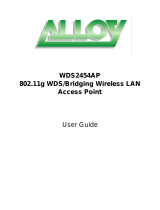
© Copyright 2012TRENDnet. All Rights Reserved.
TEW-676APBO
applications, and rely on best-effort parameters for traditional IP data.
As an Example, time-sensitive Voice & Video, and multimedia are given
effectively higher priority for transmission (lower wait times for channel
access), while other applications and traditional IP data which are less time-
sensitive but often more data-intensive are expected to tolerate longer wait
times.
Aifsn : The Arbitration Inter-Frame Spacing Number specifies a wait time
(in milliseconds) for data frames
CWmin : Minimum Contention Window. This parameter is input to the
algorithm that determines the initial random back-off wait time
("window") for retry of a transmission. The value specified here in the
Minimum Contention Window is the upper limit (in milliseconds) of a
range from which the initial random back-off wait time is determined.
CWmax : Maximum Contention Window. The value specified here in the
Maximum Contention Window is the upper limit (in milliseconds) for the
doubling of the random back-off value. This doubling continues until
either the data frame is sent or the Maximum Contention Window size is
reached. Once the Maximum Contention Window size is reached, retries
will continue until a maximum number of retries allowed is reached. Valid
values for the "cwmax" are 1, 3, 7, 15, 31, 63, 127, 255, 511, or 1024. The
value for "cwmax" must be higher than the value for "cwmin".
Txop : Transmission Opportunity is an interval of time when a WME AP
has the right to initiate transmissions onto the wireless medium (WM).
This value specifies (in milliseconds) the Transmission Opportunity (TXOP)
for AP; that is, the interval of time when the WMM AP has the right to
initiate transmissions on the wireless network.
ACM : Admission Control Mandatory, ACM only takes effect on AC_VI and
AC_VO. When you do not click Checkbox, it means that the ACM is
controlled by the connecting AP. If you click Checkbox, it means that the
Client is in charge.
AckPolicy : Acknowledgment Policy, WMM defines two ACK policies:
Normal ACK and No ACK. Click “Checkbox” indicates “No ACK”
When the no acknowledgment (No ACK) policy is used, the recipient does
not acknowledge received packets during wireless packet exchange. This
policy is suitable in the environment where communication quality is fine
and interference is weak. While the No ACK policy helps improve
transmission efficiency, it can cause increased packet loss when
communication quality deteriorates. This is because when this policy is
used, a sender does not retransmit packets that have not been received
by the recipient.
When the Normal ACK policy is used, the recipient acknowledges each
received unicast packet.
WMM Parameters of Station : This affects traffic flowing from the client
station to the access point.
Aifsn : The Arbitration Inter-Frame Spacing Number specifies a wait time
(in milliseconds) for data frames
CWmin : Minimum Contention Window. This parameter is input to
the algorithm that determines the initial random backoff wait time
("window") for retry of a transmission. The value specified here in
the Minimum Contention Window is the upper limit (in milliseconds)
of a range from which the initial random backoff wait time is
determined.
CWmax : Maximum Contention Window. The value specified here in the
Maximum Contention Window is the upper limit (in milliseconds) for the
doubling of the random backoff value. This doubling continues until either
the data frame is sent or the Maximum Contention Window size is
reached. Once the Maximum Contention Window size is reached, retries
will continue until a maximum number of retries allowed is reached. Valid
values for the "cwmax" are 1, 3, 7, 15, 31, 63, 127, 255, 511, or 1024. The
value for "cwmax" must be higher than the value for "cwmin".
Txop : Transmission Opportunity is an interval of time when a WME AP
has the right to initiate transmissions onto the wireless medium (WM).
This value specifies (in milliseconds) the Transmission Opportunity (Txop)
for AP; that is, the interval of time when the WMM AP has the right to
initiate transmissions on the wireless network.
ACM : Admission Control Mandatory, ACM only takes effect on AC_VI and
AC_VO. When you do not click Checkbox, it means that the ACM is
controlled by the connecting AP. If you click Checkbox, it means that the
Client is in charge.




















